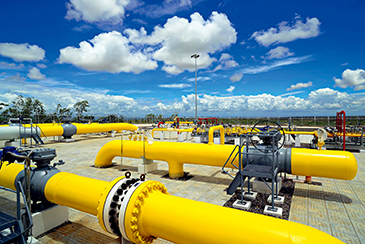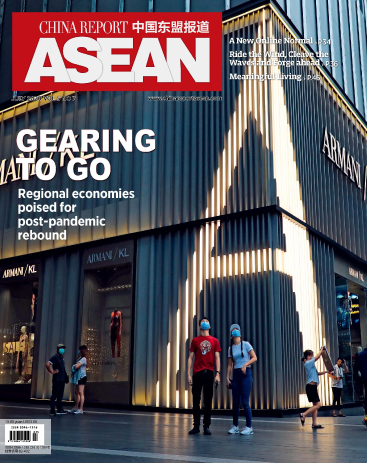Kyaukse is a town 45 kilometers south of Mandalay, the biggest city in northern Myanmar. It is home to the Mandalay gas offtake station of China-Myanmar Gas Pipeline. Every day, around 850,000 cubic meters of natural gas from the west coast of the country flow through hundreds of kilometers of the pipeline before being fed into the local gas network.
The China-Myanmar crude oil and gas pipeline project is expected to eventually transmit about 6 billion cubic meters of natural gas and 10 million tons of oil each year, which would powerfully boost the development of Myanmar’s oil and gas industry and drive economic and social development of regions along the pipelines.
Promoting Electrification
At the control center of the China-Myanmar oil and gas pipeline project, the entire pipelines traversing Rakhine State, Magwe Region, Mandalay Region and Shan State can be monitored alongside every offtake station. Supported by an intelligent control system, staff at the center can control transportation with only a few clicks. Li Zilin, a supervisor of the project managed by Sino-Pipeline International Company, said that as of June 3 the pipelines had realized two-way delivery of over 30 million tons of crude oil and 30 billion cubic meters of natural gas.
“The project is enhancing trade between China and Myanmar and helping improve Myanmar’s technologies related to the petroleum and oil industry,” said U Win Khaing, Minister of the Myanmar Ministry of Electricity and Energy. “It has been a huge boon because it will help develop the energy sector as it also satisfies the country’s demand for oil and gas.” As of May 2020, the project had generated a total of US$514 million in direct economic benefits including US$252 million from the gas pipeline and US$262 million from the oil pipeline. The project offers solutions for the country to open domestic downstream markets. The pipelines are quite lucrative: They create jobs, generate taxes and investment dividends, and promote foreign exchange through exports.
“Since they began operation, the pipelines have been significant not only for the economy in regions along the route, but also for Myanmar’s overall development,” noted U Aye Win, secretary general of the Union of Myanmar Federation of Chambers of Commerce and Industry. “In recent years, Myanmar’s economic growth has maintained between 6 percent and 7 percent, and the oil and gas industry has served as powerful support. The China-Myanmar oil and gas pipelines are important energy lines and infrastructure that effectively facilitate the industrial electrification of Myanmar.
Electrifying Life and Business
Nui is a student at Mandalay University. After the coronavirus outbreak, he has been continuing his studies online from home. The summer heat in June was quite overwhelming in Myanmar, and Nui had to blast the air conditioner and electric fans to keep cool. “Now, I don’t worry about blackouts because the new gas power plant in the suburb guarantees a stable source of electricity,” he said.
The gas power plant in question is the Kyaukse Gas-Fired Power Plant situated 50 kilometers from Mandalay. The largest internal combustion engine power plant in the country, Kyaukse Power Plant was completed in May 2019 and equipped with an installed capacity of 1.274 billion kilowatt-hours of electricity per year, enough to provide reliable power to the 2.7 million residents of the Mandalay Region. “The plant takes gas delivered from the Mandalay offtake station of the China-Myanmar gas pipeline and burns 750,000 cubic meters daily to satisfy the needs of local people and businesses,” said Aung Tun Myint, manager of the plant. “Now, downtown Mandalay is ablaze with lights, and shops and households no longer need private generators to ensure steady, predictable electricity.”
U Zaw Myint, manager of International Glass Company Limited in Kyaukse Township, recalled frequent power outages when they were relying on the spotty service of old gas plants. Except for cement plants and bike factories, local businesses had to use diesel generators and occasionally suspend production due to the intermittent power supply. “Things are different now,” beamed U Zaw Myint. “Our factory consumes 420,000 kWh of power every day, all from the Mandalay offtake station. Steady electricity has ensured smooth production, and our daily capacity has reached 200 tons of glass.”
The China-Myanmar gas pipeline project has brought remarkable changes to Kyaukpyu. The project enables businesses to run at full capacity and generate more economic benefits while guaranteeing locals steady and more affordable electricity all day and night. The little town now has more pavement, streetlamps, and beautiful houses. “We decided to open a fourth bank branch in Rakhine three years ago because we were confident about its economic potential,” said the manager of Ayeyarwady Bank.
For a Better Future
“Natural gas power plants produce about 40 percent of Myanmar’s electricity, and the China-Myanmar gas pipeline has provided major support for resumption of production during the pandemic,” said the chairman of the Myanmar Garment Manufacturers Association. The clothing industry is an important export sector for Myanmar, and as production has incrementally resumed, the country is starting to receive purchase orders from all over the world again. “Thanks to sufficient electricity delivered by the gas pipeline, we are confident about our future development.”
“The China-Myanmar gas pipeline is now delivering about 16 million cubic meters of natural gas every day,” noted Zhang Yong, director of the control center. “The offtake stations in Kyaukpyu, Yenangyaung, Taungtha and Mandalay can supply as much as 4 million cubic meters of natural gas to local consumers each day. At present, the pipeline is running well and producing enough power for local demand.”
The oil and gas pipeline project is a milestone BRI project for Myanmar and China that is creating more possibilities for both countries to benefit from further win-win projects, according to a Myanmar economist. “The complementary industrial traits of China and Myanmar mean huge cooperation potential in multiple fields including agriculture, energy, and infrastructure,” he added. “Promoting the BRI will benefit people of both countries.”
U Ko Ko Hlaing, co-founder of the Center for Strategic and International Studies of Myanmar, commented that pragmatic cooperation projects between Myanmar and China including the Myanmar-China oil and gas pipelines have created an impressive number of jobs and significantly boosted Myanmar’s economic growth. “Thanks to this series of projects, we expect Myanmar to develop steeply in technology, rail networks, and industrial parks. We will continue to work with China to promote the BRI,” he added.

Bright yellow pipes of the Yenangyaung offtake station of China-Myanmar Gas Pipeline sharply contrast Myanmar’s azure sky. (ZHAO JIANZHONG)

As of June 3 the pipelines had realized two-way delivery of over 30 million tons of crude oil and 30 billion cubic meters of natural gas.
As of May 2020, the project had generated a total of US$514 million in direct economic benefits including US$252 million from the gas pipeline and US$262 million from the oil pipeline.


 Copy Reference
Copy Reference